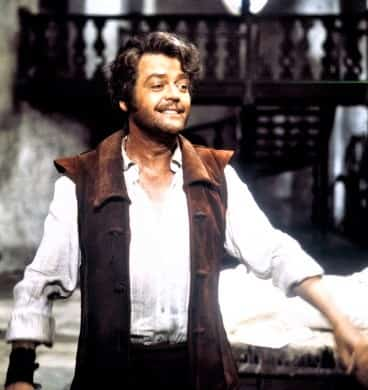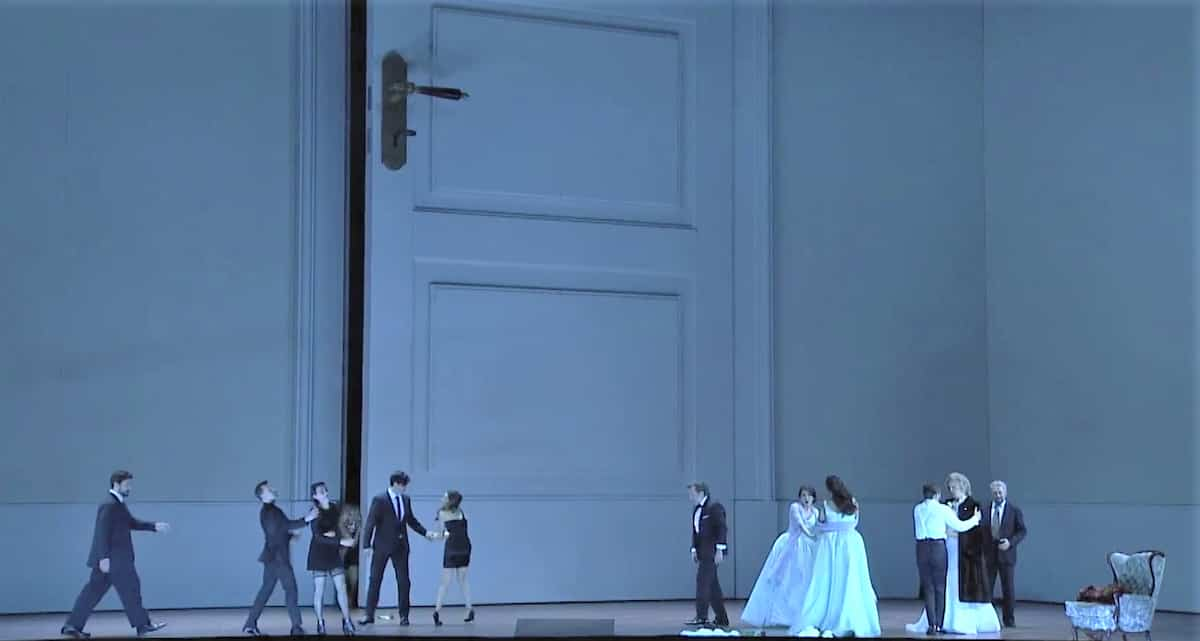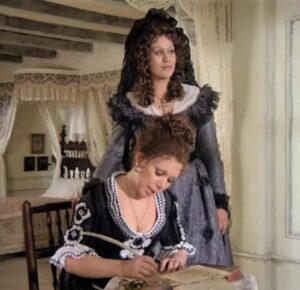Le Nozze di Figaro - The Marriage of Figaro
Le Nozze di Figaro started out in the spring of 1786, and it was an immediate success.
But before that, it was very uncertain if it ever could have been written. The play it is based on was banned from the theaters and could only be read without scenography. It was a flammable subject. Fortunately, the new court poet Lorenzo da Ponte managed to zig-zag the new opera through the censors.
And although it was balancing on a knife edge regarding scandalous behavior, and although the authoritative figure, The Count, is defeated in the end, everybody loved it. And still today, it is Mozart’s second most-played opera, after The Magic Flute.
Premiere – May 1, 1786, Burgtheater, Vienna, Austria

Composer – Wolfgang Amadeus Mozart
Librettist – Lorenzo da Ponte
Running Time – ca. 3 hours, plus Intervals
Four Acts
Ouverture – 4 minutes
Act 1 – 43 minutes
Act 2 – 50 minutes
Act 3 – 43 minutes
Act 4 – 38 minutes
In Italian
Main characters
- Figaro – Bass-Baritone. The count’s valet. About to marry Susanna
- Susanna – Lyric Soprano. The countess’ maid. Figaro’s wife-to-be.
- Count Almaviva – Baritone.
- Countess Almaviva (Rosina) – Lyric Soprano.
- Cherubino – Soprano, or sometimes Mezzo-Soprano. The Count’s page.
—————–
- Bartolo – Bass. Doctor, and Rosina’s former guardian.
- Marcellina – Mezzo-Soprano His housekeeper
- Basilio – Tenor. The music teacher
- Barbarina – Soprano. The gardener’s daughter, and actually Susanna’s cousin.
- Don Curzio – Tenor. Lawyer. Sometimes doubles as Basilio.
- Antonio – Bass. Gardiner.
Based on the comedy La Folle Journée, ou Le Mariage de Figaro (The Mad Day, or The Marriage of Figaro) by Pierre Beaumarchais. More about that here.
Download this short Pdf-guide. Print it, fold it, and keep it in your pocket as a help when you’re at the Opera. Please keep your phone turned off when inside the theater.
Background – The Opera The Marriage of Figaro is set in…
Seville.
Yes, this is yet another Opera set in the Spanish city (Check Carmen, The Barber of Seville, Fidelio, etc). The Count Almaviva is happily married to his Rosina, and everything is going fine. Now his servant is about to marry the young and stunning Susanna, and that’s where things start to get complicated.
The whole opera is set inside the Castle of Almaviva and in the gardens. Different rooms, but it’s always inside the premises.
Would you like to visit Seville?
Would you like to see the sites where the Opera takes place?
Something about the voices…
Both Figaro and the Count are Baritones (…Or Basses, the label Baritone didn’t exist in the 1700s). The role of Figaro is sometimes regarded as a Bass-Baritone, but all kinds of baritones, and basses sing Figaro. He should be slightly darker than the Count, though.
There is no real tenor role in the Opera. Often the leading heroe, the main lover is a tenor. But the only tenor here is a funny/ridiculous fellow, Basilio/Don Curzio. These two roles are sometimes doubled. The same guy sings both.
Cherubino is sung by a Soprano or a Mezzo-Soprano, a woman. These trouser roles were incredibly popular back in the days. A woman in men’s clothes also had a strong sexual charge. Mozart uses this to portray the young boy as an incontrolable sex-maniac.

Before running into the plot you need to know about Jus primae noctis.
Jus primae noctis was a legal right of the medieval Feudal Lord. He could use subordinate women for his own pleasure. The words in Latin means “Right of the first night”, indicating that the Lord had a legal claim to the bride’s first night after the wedding.
How frequent this was in reality, and if it was ever a formal legal right, is very uncertain, to say the least. It’s been suggested that it was more of a monetary tax. The documentation about it is almost exclusively from periods after it supposedly had been abandoned. If the Noble would actually have imposed such a right, it probably wouldn’t have done well for the general peace of mind among his subordinates.
Anyway, the Count is trying to force this law on Susanna on the first night after the marriage. He already abolished it once, but the beauty of the young girl has made him change his mind. Almaviva wants his prey. And this is where we start the Opera…
Plot
Remember that this is a classical comedy with lots of entanglements, and misunderstandings. People get locked into things and locked out of things. There’s a lot of entering and exiting, and everybody is in love but with the wrong subject. It is funny, but the plot is complicated. To enhance the funny dialogue, there’s much more recitativo – talking – than there are songs. Like a Woody Allen-film to music. And again Mozart shows how modern he is. Much of the humor is more or less applicable even to today’s audience, just like it was written.
If you can’t follow every turn in the very intricate drama, you are forgiven. It’s quite enjoyable all the same.
Ouverture
Act 1 – Figaro’s and Susanna’s Apartment.
The Opera starts with a duett, where Susanna sings about her coming matrimony, and Figaro sings:
– Cinque… dieci (Five… ten… twenty… thirty… thirty-six… forty-three…)
He’s measuring for the refurbishing that will be done, once they’re married.

Susanna tells him about the count’s plans, about the Jus primae noctis. She also mentions that Basilio, her singing-teacher, is in on it. She rushes away since the Countess calls for her.
———-
Now there’s a wonderful aria by Figaro…
– Se vuoi ballare, signor Contino… (If you want to dance, my little Count, I will play the guitar…)
It’s a happy and innocent dancing tune.
What Mozart does is put Figaro’s angry and threatening words into a typical noble dance-form, the Menuette. This serves two purposes.
- Figaro shows that he will beat the count in his own back yard, in a Menuette-style. A normal peasant wouldn’t know about Menuetts.
- It makes it clear to the audience, that we’re still within the realm of comedy. The situation could otherwise be quite brutal.
———-
There’s a short scene with Don Bartolo and Marcellina, his not so very young housekeeper. She has a contract in which Figaro is forced to marry Marcellina due to an old unpaid debt. Bartolo, who’s eager to get back at Figaro, sings La Vendetta (revenge). The situation refers to the prequel, The Barber of Seville.
Bartolo exits, Susanna enters and the two rivals sing
– Via, resti servita, madama brillante…
Young, adolescent, hormone-fueled love.
The next character introduces himself… Cherubino, the page. This is a young boy in love with more or less everything that moves. But his heart is devoted to the Countess, whom he cannot get out of his head. He gives Susanna a poem to read to the Countess… Or to any other woman in the palace. He sings another little masterpiece:
– Non so più cosa son, cosa faccio… (I don’t know who I am, what I do…)
———

The Count enters, forcing Cherubino to hide behind a sofa. Almaviva asks Susanna for a meeting in the Park at dusk. They are interrupted by Basilio, the music teacher. The Count has to hide too, forcing Cherubino to change place. Now they are two behind the furniture.
Basilio, who is a slanderer, insinuates that everybody knows about the Count and Susanna. Then he insinuates that everybody also knows about Cherubino and the Countess, which makes the Count jump out from behind the sofa. Basilio, Susanna, and Almaviva sing the trio:
– Cosa sento! Tosto andate, e scacciate il sedutor. (What am I hearing? Go, throw out the seducer.)
At a certain point, the Count himself reveals Cherubino under a blanket. Some inquiry and he gets to the conclusion that not only is the young boy madly in love with his wife, but he has also heard about his own passion for Susanna. The count decides: Cherubino has to go.
They are again interrupted. This time by Figaro together with half the village. They celebrate the Count and his gentle and noble manners. And honor him for having abolished the infamous Jus primae noctis. (This is obviously a trick to getting the Count to promise in front of everybody, not to touch Susanna).
The Count dodges the bait, but thanks, everybody.
Then he turns to Cherubino
– Ok, I forgive you. I will do more than so. In my regiment, there’s a vacant post as an officer. I hereby appoint you… Goodbye!
The Act finishes with a true Mozartian masterpiece sung by Figaro:
– Non più andrai, farfallone amoroso… (No more running around here, you little lovesick butterfly)
Figaro – Renato Capecchi
Act 2 – The Countess’ Apartment.
The last of the main characters is presented: Countess Rosina. She sings a short and very sad Aria:
- Porgi, amor, qualche ristoro… (In it she complains about her misfortune in love.)
Rosina – Irmgard Seefried
Susanna enters and after a while even Figaro. The three of them are all on the same page when it comes to teaching the Count a lesson. The plan is as follows.
Figaro has informed the Count (through Basilio) that the Countess has an encounter with an admirer in the Park. (The Count will suspect it to be Cherubino…)
Then Susanna will accept the meeting with the Count in the Park at more or less the same time. They will send Cherubino, dressed in women’s clothing, to take her place.
Figaro leaves but sends in Cherubino to get dressed as a woman. He sings the poem, he gave to Susanna in the first act:
– Voi che sapete… (You, who understand what love is, look at my heart. All this desire and affection is new to me… And I don’t understand it.)
The two women are touched by this young boy, discovering his manhood.
Now follows a scene where the women dress up the young lover-boy as a woman, while Cherubino tries to declare his overwhelming love for Rosina.
————
There’s a knock on the door. Panic! Cherubino hides in the Cabinet.
Count Almaviva enters, and this happens:
- The Count is suspicious about the locked door.
- Then he hears a sound from the Cabinet.
- The Countess tries to convince him that Susanna is in there and that she’s locked the door from the inside.
- Susanna comes into the room but immediately hides.
- The Count runs away to get tools to force the door. But to secure the premises, he locks the door from the outside.
- Susanna and Cherubin sing the fast duet “Aprite presto, aprite” while they change places, and one of them has to jump from the window.
When Almaviva returns and Susanna comes out from the Cabinet, he has to accept his defeat. But it doesn’t end here.
Figaro enters, denies his knowing about the note to the Countess, and tries to grab Susanna to get ready for the matrimony.
Now the gardener, Antonio, enters. He says he saw a figure jumping from the Cabinet. And the jealousy of the Count is igniting again. Figaro tries to dodge the attacks, taking the blame. He says he’s the one who jumped out the window but he has difficulties explaining why.
When finally Don Bartolo, Basilio, and Marcellina enter to enforce the contract between her and Figaro, confusion is total. The Act finishes in a Grand Final with everybody on stage…. Except for Cherubino.
Act 3 – Main hall of the castle.
Let’s try to reason a bit about the situation.
The Count wants to be sure Cherubino is out of the way. So, he has sent Basilio to Seville to check on him. He still doesn’t know if his wife knows about his plans to seduce Susanna. However, he could squeeze his servants not to talk, or he shall make Figaro marry Marcellina.
Susanna reasons with him and confirms the encounter for that same evening. She also sort of insinuates that if Almaviva would pay Figaro’s debt to Marcellina…
Figaro arrives and he leaves together with Susanna. As they’re leaving, she says::
– Don’t worry, you’ve already won…
When he’s left alone, the Count, having heard that remark, has a solo scene:
– Hai già vinta la causa! – Vedrò, mentr’io sospiro (So, you’ve already won… Practically he says: I will not be defeated by a servant. It’s not right that I, his master, should be deprived of pleasures that he is free to enjoy.)
———-
Again the room is filled with people. Figaro, Basilio, Marcellina, and Don Curzio, the lawyer. Marcellina is about to claim her prize, the hand of Figaro in marriage. When all of a sudden they discover that Figaro is actually her son and Basilio’s. He was kidnapped many years ago. So, that solves the situation, as the newfound parents are all too happy to let Figaro marry his bride. Basilio even put in some of his own money for the wedding. As well as deciding to propose to Marcellina on the spot. There will be a double wedding.
———–
There’s a short scene with Cherubino and yet a new girl, the daughter of Antonio, the gardener. Her name is Barbarina.
———–
Alone, the Countess sings:
– E Susanna non vien – Dove sono i bei momenti. (Again, she complains about the infidelity of her husband, and how the happy times are gone.)

When Susanna enters, together they sing a beautiful duet: Canzonetta dell’aria. The Countess is dictating a letter for Almaviva, confirming the appointment for the evening.
The two women have actually modified Figaro’s plan. Now it’s Rosina instead of Cherubino, who’s dressed up as Susanna and is going to meet with the Count. Figaro is unaware of this.
The letter is sealed with a pin.
———–
Then the village girls arrive and among them, there’s once again… Cherubino, dressed as a girl… The Count, who’s entered sees him but Barbarina, asks for his forgiveness. She then insinuates that the Count has been courting her too. She then asks for Cherubino’s hand in marriage.
So, now we’ve engaged Figaro and Susanna, Bartolo and Marcellina, and even Cherubino and Barbarina. The only ones left now are the nobles.
The famous letter with the Countess’ pin is delivered to the Count
The Act finishes with everybody on stage. Grand Final with the chorus.
Act 4 – The Park
Let’s tie up the loose ends.
Barbarina, has lost a pin. And while Figaro helps her finding it, he starts to doubt the honesty of his wife to be…
– (Is it possible that she’s actually cheating on him with Almaviva?)
Marcelina engages to help Susanna. (Loyalties change rapidly…) Marcellina sings a very interesting Aria:
– Il Capro e la Capretta (The goat and the goatess…)
We can assume that Mozart was very attracted to women, love, and sexuality in general. He treats these subjects with a delicate, and knowing hand. The text goes like this:
– The beasts in the forest have no problem with their spouses, The she-goat and the he-goat get along just fine… Only us, women, who love our men-folk, have to put up with being treated so badly by them.

Now we are arriving at the conclusion.
- Susanna, together with Marcellina, has made Figaro believe that she has an encounter with the Count. Figaro is spying on her.
First, he sings an Aria:
– Aprite un po’ quegli occhi. (Open your eyes to what women are like, Those you call Goddesses. They are witches…)
Then she sings another jewel of wonderful music.
– Giunse alfin il momento – Deh, vieni, non tardar. (Finally the time has come – Hurry, don’t hesitate)
This is a complete confession of her great emotions and the love she feels for Figaro. He, hiding in the bushes, hears a very different interpretation in her words.
- Barbarina has an encounter with Cherubino.
- Rosina is dressed up as Susanna.
- In the background not only Figaro sneaks around, but also Almaviva and Marcellina, and a whole lot of other people as well.
Cherubino sees the Countess but he thinks it Susanna. Young and eager that he is, he hits on Susanna. one is as good as the other. The Count jumps out from the bushes, furious that he can’t get him to leave his women alone, and stay in Seville. Then Figaro jumps out but hides again without being detected. The Count pursues his seduction of his own wife, complimenting her for her attributes…
————
The Forrest is now full of people hiding but still seeing and hearing… And the confusion increases. A classical Opera Buffa – Comic Opera. After quite a bit of exposing, hiding, and running around, somehow the ends that are still lose get tied.
————
The end of the Opera is traditional. After Almaviva has asked his wife for forgiveness, everybody joins the Count and the Countess in the big happy finale. Rosina is a noble and generous woman… Just like it’ was supposed to be for the Court of Joseph Benedict Anthony Michael Adam the 2nd, Emperor of the Holy Roman Empire.
 Things to look out for
Things to look out for
First Act
0 minutes Cinque… Dieci… The duet between Susanna and Figaro
9 minutes Se Vuoi ballare, Signor Contino… Figaro’s Aria
21 minutes Non so più cosa son, cosa faccio… Cherubino’s Aria
25 minutes The Count hides behind the sofa, which forces Cherubino to change his hiding place.
28 minutes The Count jumps out from behind the furniture.
40 minutes Non più andrai, farfallone amoroso Figaro’s Aria
Second Act
0 minutes Porgi, amor, qualche ristoro… Rosina’s 1st Aria. Difficult, delicate, but if sung well, immensely beautiful.
9 minutes Voi che sapete che cosa è l’amor… Cherubino’s Aria
20 minutes The Count enters, and the long scene with Cherubino locked in the Cabin starts.
Third Act
6 minutes Hai già vinta la causa – Vedrò mentr’io sospiro… Almaviva’s Aria
——- These scenes could be reversed.
12 minutes The scene were Figaro finds his parents.
20 minutes E Susanna non vien – Dove sono i bei momenti… Rosina’s 2nd Aria.
——-
Fourth Act
0 minutes L’ho perduta… Barbarina’s short, but cute Aria.
5 minutes La capra e la capretta… Marcellinas short, but equally cute, as well as enlightened Aria.
10 minutes Tutto è disposto – Aprite un po’ quegli occhi… Figaro’s jealousy-Aria.
15 minutes Giunse alfin il momento – Deh, vieni, non tardar… Susanna’s true-love-Aria.
After that, you just have to stay tuned until the end.
About the Opera
Mozart had moved to Vienna already in 1781. After practically being kicked out from his former employment in Salzburg, he had installed himself as one of the most prominent composers and performers in the Capital.
But he couldn’t land a royal commission. Famous, yes, popular, yes, and he even made quite a lot of money. But to be really important, he still needed to write an Opera for the Court… In Italian.

He went through hundreds of manuscripts. But it wasn’t until he met the newly appointed court-poet Lorenzo da Ponte, that it clicked. They immediately connected. Mozart brought the new play by Pierre-Augustin Caron de Beaumarchais to da Ponte, who had to make huge cuts, and rewritings.
The problem with the play was, that it had a Servant outwit a nobleman. Servants outwitting their masters was in no way new. Medieval literature is full of it. but the fact that the master was a Count, and as such almost a king, or an emperor, was extremely flammable.
It had to be carefully treated, the characters had to be portrayed in a certain way, and the plot had to be about anything, but politics. We can easily say today, that the balance is perfect. And the Emperor Joseph II thought so too, after it had been delicately presented to him by Da Ponte.
It premiered in spring 1786, with a huge success. A popularity it has held until modern times. It is, after The Magic Flute, Mozart’s most performed opera.
Fun Facts
- One way to shade the rebellious subject is obviously to redirect the focus. Both men, the servant and the nobleman, are outwitted by the women, Susanna and Rosina. In fact, even Marcellina, the old hag, turns into a rather knowledgeable and likable mother kind of woman, as the Opera progresses.
- The Opera “Il Muto” performed in the 1st Act of Lloyd-Webber’s musical: The Phantom of the Opera, is based on The Marriage of Figaro.
- New productions involve new strategies. At Teatro La Fenice, Venice, Italy in 2011, the director Damiano Michieletto decided to change ending. At the final accord, the Countess steps up to the window, about to throw herself out, ending her life in a tragical suicide.
- The play by Pierre Beaumarchais, was a sequel to the at the time immensely popular “The Barber of Seville” (The play, not the Opera by Rossini, That came many years later). But while The Barber was let through the censors, the Marriage of Figaro was stopped. Beaumarchais tried to rewrite it but it couldn’t be performed. However, he was allows read the play, just one person reading in front of the audience, and as such it came to the knowledge of Mozart.
- For the context… The play was first allowed to perform in 1784, the Opera in 1786, and the French revolution broke out in 1789.
- Lorenzo da Ponte actually died as an American. Due to unpaid debts he had to escape London in 1805 and cross the Atlantic. In the US, he then pursued an academic career. He died in New York in 1838.
Download this short Pdf-guide. Print it, fold it, and keep it in your pocket as a help when you’re at the Opera. Please keep your phone turned off when inside the theater.